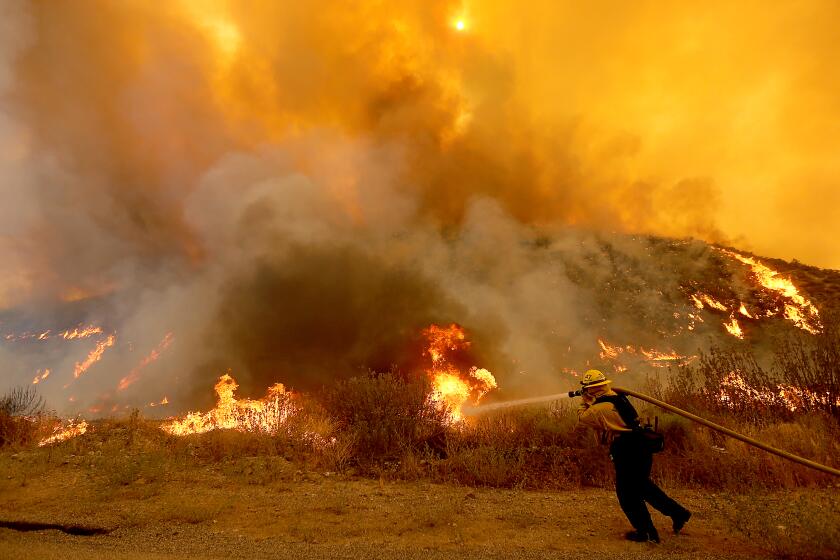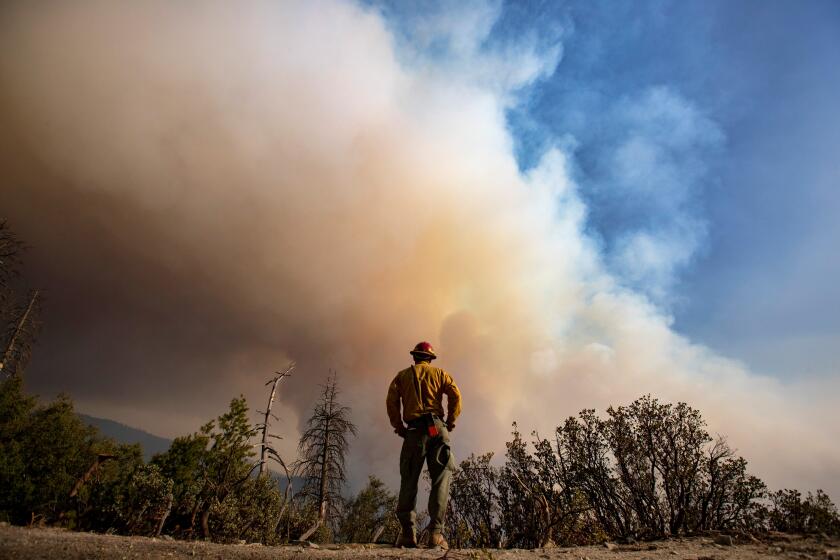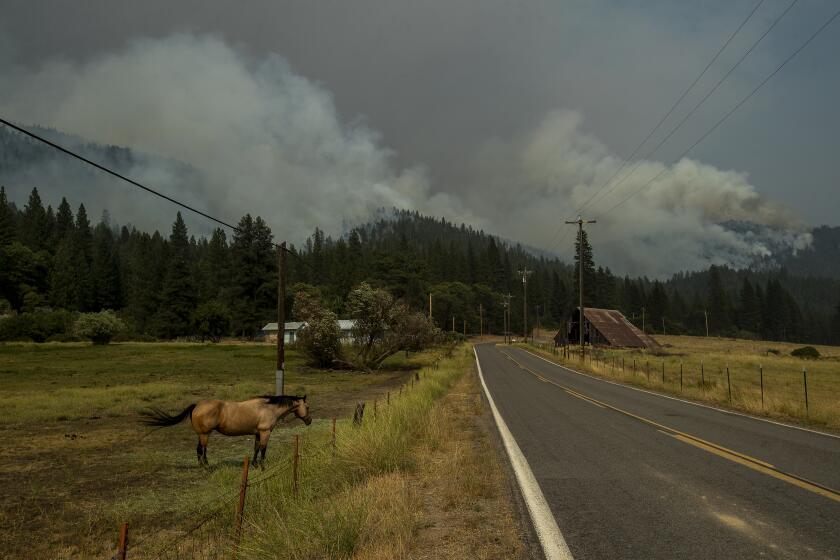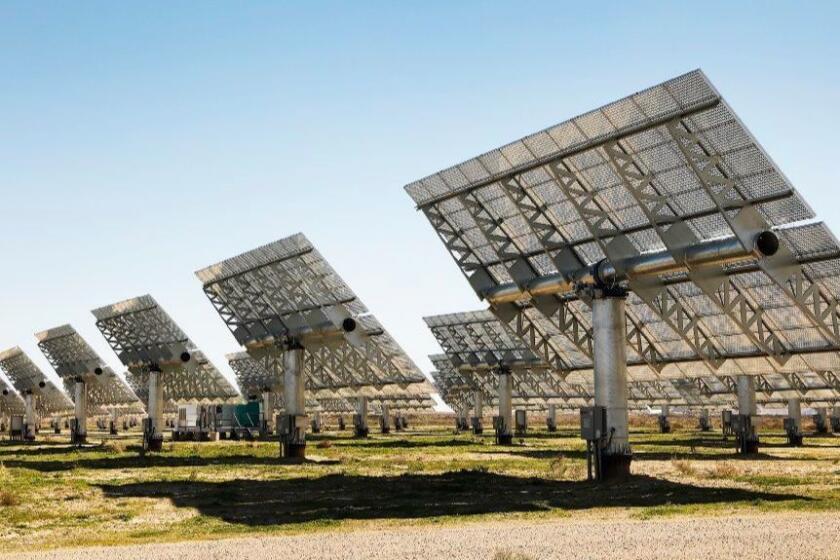Wildfires knocked out power to an entire California county. The unprecedented fight to bring it back
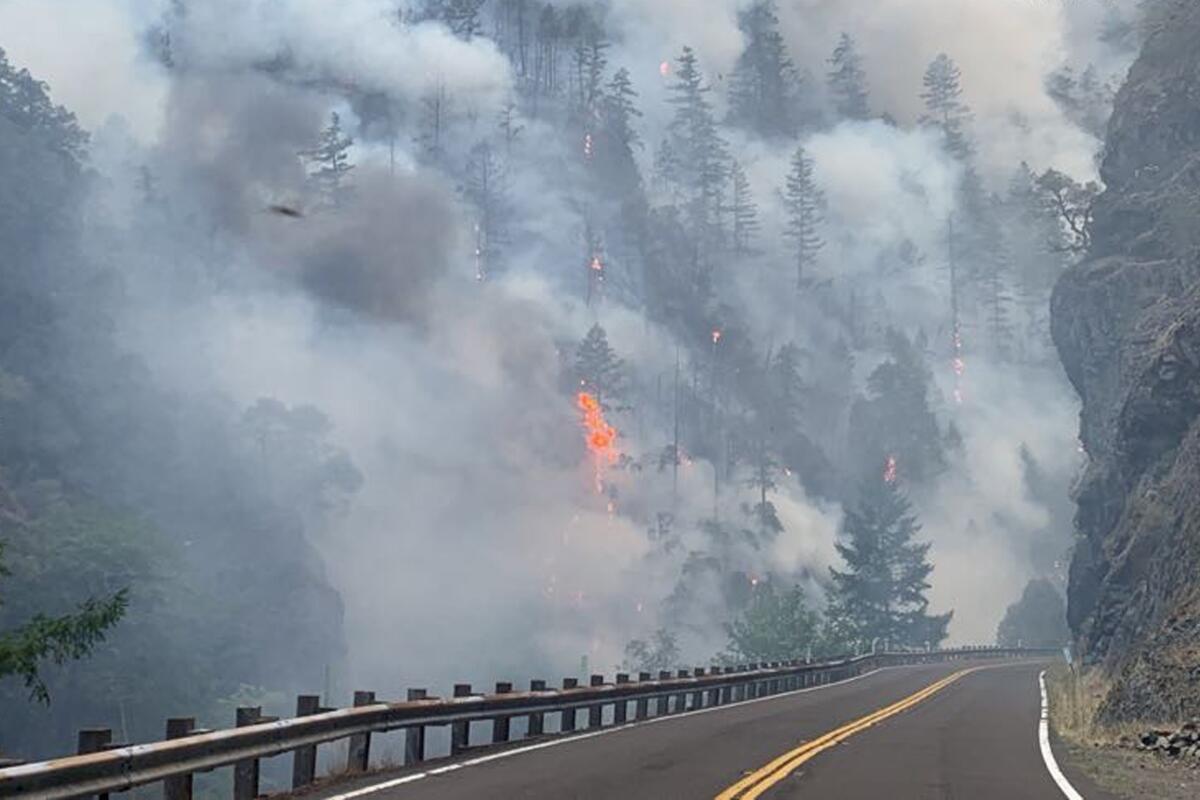
- Share via
After an onslaught of about 150 lightning strikes in one of California’s most drought-stricken regions last month, more than two dozen fires spread quickly across the rugged wilderness of the state’s northwest corner.
In their path was a piece of crucial infrastructure: the only transmission lines that provide power to Del Norte County’s 27,000 residents.
Soon, the entire county was dark, giving local officials little time to prepare as businesses closed, evacuations expanded and warnings of an extended outage — one that could leave radio as the most reliable means of staying informed — became more plausible.
But within days of the widespread outage, officials began bringing homes and businesses back online through a patchwork of generator-powered microgrids that could run separately from the fire-threatened transmission lines. That setup powered Del Norte County for nearly a month until the main lines were re-energized Sunday, forming what appears to be the state’s largest and longest-running microgrid operation powered by large generators.

“This was one of those all-hands-on-deck moments,” said Stefan Bird, the chief executive of Pacific Power, a branch of PacifiCorp that provides electricity to 800,000 across Northern California, Oregon and Washington. “The scale of deployment in this case was unprecedented.”
With assistance from Pacific Gas & Electric, Pacific Power’s utility counterpart to the south, officials brought in dozens of tractor-trailer-sized generators, restoring electricity one section at a time. Within a week, all non-evacuated residents had their lights back on, without any usage restrictions.
“For the first time, an entire county’s electric needs were supplied by commercial generators powering substations, providing temporary electrification for the community,” state Senate Majority Leader Mike McGuire (D-Healdsburg), who represents Del Norte County, said in a statement. “This was a remarkable achievement, all things considered.”
Although McGuire said the novel response surely helped limit damage from the Smith River Complex wildfires — the state’s largest of the year — their size and scope have been staggering. Businesses and residents have reported losing thousands of dollars, according to the Wild Rivers Outpost, and firefighters have confirmed at least 12 structures destroyed.
Microgrids in a matter of days
On Aug. 18, three days after the fires erupted, county officials warned residents about possible electricity disruptions as the wildfires ballooned, but they remained focused on issues that appeared more urgent: issuing the first of many mandatory evacuations for rural North Coast residents and closing a large section of U.S. Route 199.
Just hours later, Pacific Power updated its outlook: Widespread outages were imminent.
“It was a surprise, I think, to everyone that the fire was that close and that the power would be shut down in that short a time frame,” said Eric Wier, city manager for Del Norte County’s largest population hub, Crescent City. “We thought we would have a couple of days to plan.”
Once power was lost, local, state, federal and utility officials began coordinating emergency procedures: setting up temporary shelters with power stations, air-conditioning and water supplies; providing small-scale generators to medically vulnerable residents; and determining what other crucial facilities needed backup power.
“You don’t realize the amount of ripple effects that can happen when all of a sudden you don’t have a critical infrastructure piece, like power. … It is life or death for a lot of people,” Wier said. “Being a rural community, not everyone is on community-supplied water … [so] as soon as that power goes out, they don’t have water either.”
Officials worried about how dialysis patients would receive their treatment, how well-water homes would flush toilets and when people would start running out of food as refrigerators warmed. Issues only mounted as the time without power grew; after just 24 hours, some of the county’s small-scale generators, including at the jail and a shelter, started to fail, Wier said.
“We didn’t know what the length was going to be,” Wier said. “I didn’t think bringing in generators to power an entire community was even a possibility.”
Scientist Patrick T. Brown said he withheld the full truth to get his California wildfire research published in Nature. A firestorm followed.
Del Norte County, which covers 1,200 square miles, and Crescent City, home to about 6,000 residents and the county’s only incorporated city, are powered entirely by two redundant transmission lines, according to Pacific Power. The separate lines with built-in backups provide some resiliency, but not against physical threats, as they run along the same corridor from Oregon.
For more than three weeks, Pacific Power remained unable to re-energize the only lines that link Crescent City and Del Norte County to the power grid.
“Without those lines, [these areas] are effectively islanded,” Bird of Pacific Power said, which is why locally based power was a viable solution.
Within two days of the outage, Pacific Power and its partners had transported and connected the first of the large, commercial-grade generators, restoring power to essential businesses such as grocery stores, gas stations and pharmacies.
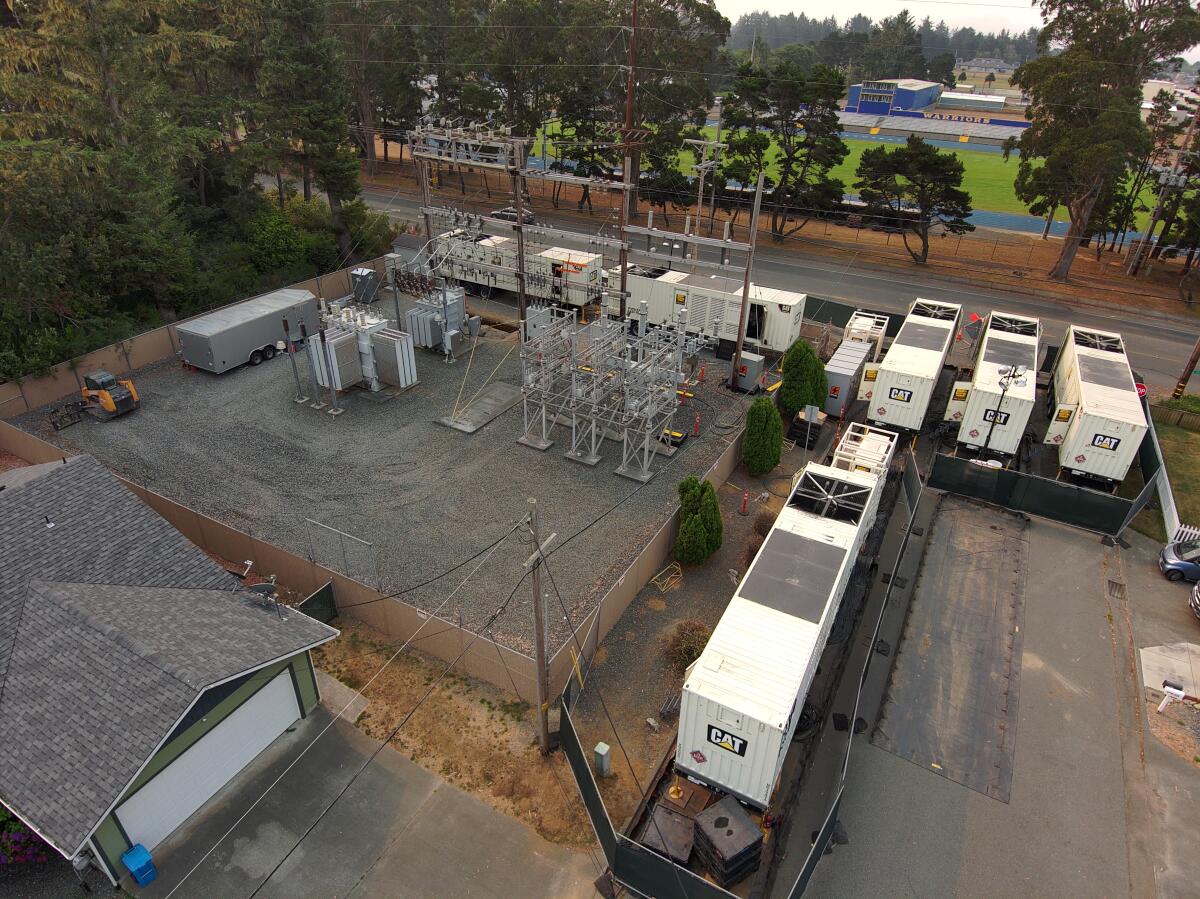
Four days after the shutoffs — when the fires had spread to 40,000 acres, still without any containment — dozens of diesel-fueled generators had been installed, providing power to 4,000 customers in the Crescent City area, according to updates from Pacific Power. An additional 3,000 customers were brought online the following day as generators were set up at more substations.
By Aug. 25 — seven days after the initial outage — nearly all of Del Norte County had power restored, officials announced. (Mandatory evacuation zones still did not.)
PG&E provided the majority of the large-scale generators through mutual aid and also lent utility crews for emergency support, said Angie Gibson, PG&E’s vice president of emergency preparedness and response.
“We were able to mobilize close to 40 megawatts of generation up to six of their substations up at Pacific Power, as well as to the Pelican [Bay] State Prison,” Gibson said. At each substation, several of the 1.5- or 2-megawatt generators were connected, working together to be able to pick up the full load, she said.
“We have the opportunity to share innovation,” Gibson said. “The customers up there are amazing … we’re very privileged to be able to do this for them.”
Global warming is ratcheting up the risk of extreme wildfire growth in California and will continue to do so for decades, even if emissions are reduced.
PG&E has been building up its fleet of backup generators in an effort to minimize interruptions during “public safety power shutoffs,” which are increasing in frequency, especially in Northern California as climate change accelerates extreme wildfire growth. Since the deadly 2018 Camp fire, which was sparked by PG&E power lines, utilities have used the planned shutoffs to reduce unintentional sparks during elevated fire-risk conditions, often leaving unaffected areas without power.
PG&E also has rolled out these larger-scale generators during other emergencies, such as this winter’s drenching storms — often placing them at several locations to minimize outages. During those storms, PG&E distributed 267 megawatts of backup power from the large generators, Gibson said — a much larger scale than in Del Norte County, but spread across several service areas and crises.
“When you make those investments, it does allow you to do different things in emergencies,” said Michael Wara, the director of the Climate and Energy Policy Program at the Stanford Woods Institute for the Environment. “It’s creating resilience, and that’s what we need to do — particularly up in that neck of the woods, given the fire risk.”
During the wildfire response, Pacific Power utilized 44 commercial-grade generators to serve 13,000 customers across Del Norte County and distributed more than 200 residential generators, said Tiffany Erickson, a spokesperson for PacifiCorp. The large generators averaged about 47,000 gallons of diesel every 24 hours, she said, refueling two to three times a day.
For the record:
6:50 p.m. Sept. 26, 2023An earlier version of this article said each Pacific Power commercial-grade generator averaged 47,000 gallons of fuel every 24 hours. The fuel total was for all 44 generators.
Although powering an entire community on diesel generators is “certainly not as cost effective” as standard power sources, Bird said, Pacific Power was “grateful for the ability to be able to provide this solution.”
The total cost of Pacific Power’s operation was not yet available, Erickson said, but she noted that customers would be charged at existing rates for the three-week period of generator power.
The Northern California utility said its fire safety settings turn off power to a circuit “within one-tenth of a second” of a fault, such as a tree branch falling onto a line.
“I can’t say enough about Pacific Power and the job that they were able to do to really respond to this disaster in a timely fashion,” Wier said, “and do something that I don’t think has ever been done before.”
A more resilient future
Although the diesel-fueled generators proved vital for Del Norte County, Wara pointed to Native American tribes in nearby Humboldt County that have turned to more sustainable microgrids with a combination of solar, batteries and natural gas.
The Blue Lake Rancheria tribe, northeast of Eureka, has invested in a complex system of green energy that proved stable even during surrounding outages from wildfire prevention shutoffs and an earthquake. And some utility companies have taken similar steps; in the desert of Borrego Springs, San Diego Gas & Electric Co. has built a microgrid of lithium-ion batteries, in hopes of keeping power on during inevitable emergency outages.
Rachel McCain, the natural resources director for the Tolowa Dee-ni’ Nation in Del Norte County, said tribal leaders there are increasingly thinking about ways to improve utility independence.
“It’s definitely higher on the list after all this,” McCain said. “We do have a rich fire history, but the intensity we saw this year and the rate of growth was not something we usually deal with…. This is definitely the biggest fire we’ve dealt with in about 30 years.”
Bird said his team is also considering ways to make the county more resilient and sustainable.
“This new reality that we’re in of extreme weather, the threat of wildfire — it’s just bigger than any single company, industry or community,” Bird said. “That challenge is continuing to exist across the West as we move forward, so there’s a lot to do.”
To the untrained eye, the shipping containers clustered on the outskirts of Borrego Springs don’t look like an innovative clean-energy technology that could help California cope with wildfires.
And the emergency in Del Norte County isn’t over.
The Smith River Complex fire, which jumped the border into Oregon, has burned 86,000 acres, mostly in the Six Rivers National Forest, and is just 21% contained, according to fire officials. Air quality in the region remains low and fuels are dry, as the blaze burns in California’s only location still facing moderate drought conditions, according to the U.S. Drought Monitor.
“That [power] could go off anytime; the fire is still burning; the trees could still fall,” McCain of the Tolowa Dee-ni’ Nation said. “I’m happy that Pacific Power was quick in their response, and I do think they did a good job, but we need some sort of power system that doesn’t require that much work. … We can’t just run diesel generators for everything.”
Pacific Power said it is determining “what long-term system upgrades can also provide an alternate solution, including new transmission lines and redundant infrastructure,” said Erickson, the company spokesperson.
McGuire, the state senator, called for more readily available backup generation and a second set of transmission lines — both expensive ventures.
“This fire did highlight the lack of resources immediately available in this remote and beautiful region of the Golden State,” McGuire said. “We know with a changing climate, all utilities must be better prepared to have resources on the ground and in the impacted county they serve.”
More to Read
Sign up for Essential California
The most important California stories and recommendations in your inbox every morning.
You may occasionally receive promotional content from the Los Angeles Times.
